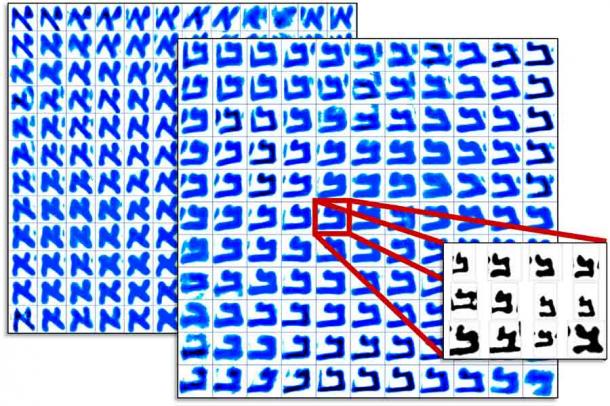After 70 years of research and controversy, scientists have finally gained intimate insights into the scroll scribes that produced the Dead Sea Scrolls, after advanced AI was used to analyze their handwriting. The Dead Sea Scrolls are ancient Jewish and Hebrew religious manuscripts that were found in the Qumran Caves in the Judaean Desert on the northern shore of the Dead Sea in the West Bank (Palestine) between 1946 and 1956. Dated to as early as the 8th century BC, and as late as the 11th century AD, the individual scroll scribes behind the scrolls have always eluded scientists, until now.
Back when the scrolls were written there was less ego and more soul in the arts of writing and this meant scribes and artisans remained anonymous, working for a higher reason than recognition. Now, a professor from the University of Groningen claims to have used Artificial Intelligence (AI) to “crack the code” of the scrolls.

How computer vision, using AI, was superior to human vision for identifying individual scroll scribes. ( willyam / Adobe Stock)
Dead Sea Scroll Scribes: How AI Is Better Than The Human Eye
A new study published in the journal PLOS ONE shows how the team of researchers were able to “identify” the individual scroll scribes who created the scrolls anonymously.
Dr Mladen Popović is a professor of Hebrew Bible and Ancient Judaism at the Faculty of Theology and Religious Studies at the University of Groningen , Netherlands, and his team set out to find a “smoking gun” in the ancient scrolls.
An article in New Scientist explains that researchers traditionally hunted for specific “traits in the styles of letters to help identify different scribes.” However, Professor Popović said this type of identification method is “somewhat subjective and often hotly debated.”
The trouble is every pair of human eyes interprets tiny twists and turns differently, and traditional methods of grouping as such have been prone to great inaccuracies and contrasting interpretations.

Greyscale image of column 15 from the Great Isaiah Scroll (left). From the red boxes (right) of the last two images one can see how the rotation and the geometric transformation is corrected to yield a better image for further processing. (Brill Publishers / PLOS ONE )
“How” Scroll Scribes Wrote: As Important As “What” They Wrote
Accurate science has no room for the greatest variable of them all, the human eye , and to crack the code of the scrolls Dr Popović removed humans from the observation process. Teaming up with Dr Lambert Schomaker, professor of Computer Science and Artificial Intelligence at the Faculty of Science and Engineering, and PhD candidate Maruf Dhali, the team of researchers launched The Hands that Wrote the Bible project.
Dr Schomaker is a specialist in writing code to allow computers to read handwriting from historical materials and according Live Science he has also investigated how “biomechanical traits,” like the way in which people hold writing tools, affects handwriting.
The team focused their efforts on the famous “ Great Isaiah Scroll ” (1QIsaa) that was discovered in Qumran Cave 1, that contains the letter aleph, or “a” at least five thousand times.
Imagine comparing the same 5000 letters by eye, and then attempting to group them. Impossible right? Well not for a computer that can be coded to hunt out and group micro-differences in curvature (textural), and in whole characters (allographic).

How the AI algorithm found the same character across the same scroll to “see” how they differed and thus if it was written by the same scroll scribe or another scribe. ( PLOS ONE )
The AI Algorithm That Identified Different Scroll Scribes
An AI algorithm was written so that the ancient text could be separated from its leather or papyrus background media. Dhali developed “a state-of-the-art artificial neural network that can be trained using deep learning,” according to the new paper.
The results of the analysis showed “54 columns of text in the Great Isaiah Scroll fell into two different groups that were not distributed randomly through the scroll, but were clustered, with a transition around the halfway mark.” This means there was more than one writer.
To ascertain how many people created the scrolls, Dr Schomaker recomputed the similarities between the columns and he discovered that although their writing was very similar to the first scribe, a second scribe showed more variation within his writing than the first.
It had always been suggested that the positioning of the text meant that after column 27 a new scribe had started. The team of researchers created heat maps that incorporated all the variants of different characters across the scroll and an average version of this character was formed for the first 27 columns and the last 27 columns.
With this new accurate quantitative analysis of the handwriting the researchers have demonstrated how the separation is “ statistically significant ,” and something the human eye could never see.
Dr Popović concluded that after seventy years of study, “this feels as if we can finally shake hands with them through their handwriting.”
This state-of-the-art approach to the study of ancient texts has introduced an entirely new way of analyzing the Qumran texts, based not on the human eye, but on physical characteristics identified by AI.
Naturally, this new method of analysis will be rolled out to analyze other ancient texts all over the world.
Top image: Artificial Intelligence proves superior to the human eye in identifying the Dead Sea scroll scribes. Source: vadiml / Adobe Stock
By Ashley Cowie
 RSS Feed
RSS Feed















 April 23rd, 2021
April 23rd, 2021  Awake Goy
Awake Goy  Posted in
Posted in  Tags:
Tags: 













